Export responses/de: Difference between revisions
From LimeSurvey Manual
Maren.fritz (talk | contribs) (Created page with "=Antworten nach SPSS exportieren=") |
Maren.fritz (talk | contribs) (Created page with "SPSS Statistics ist ein Softwarepaket, das zu statistischen Analysen verwendet wird. Sie können das offizielle SPSS-Paket nutzen, oder [https://www.gnu.org/software/pspp/GNU...") |
||
| Line 145: | Line 145: | ||
SPSS Statistics | SPSS Statistics ist ein Softwarepaket, das zu statistischen Analysen verwendet wird. Sie können das offizielle SPSS-Paket nutzen, oder [https://www.gnu.org/software/pspp/GNU PSPP] als Ersatz für das proprietäre Programm SPSS verwenden. | ||
To export your response data to SPSS, go to '''Responses & statistics''' section and select the SPSS-corresponding option located under the '''Export''' menu: | To export your response data to SPSS, go to '''Responses & statistics''' section and select the SPSS-corresponding option located under the '''Export''' menu: | ||
Revision as of 14:38, 13 July 2023
Sobald Ihre Umfrage aktiv ist, können Sie die Antworten durchsuchen und sie für weitere Analysen exportieren. Um auf die Exportfunktion zuzugreifen, klicken Sie auf Antworten (wird in jedem umfragebezogenen Bereich angezeigt) und klicken Sie dann im Dropdown-Menü auf Antworten und Statistiken.
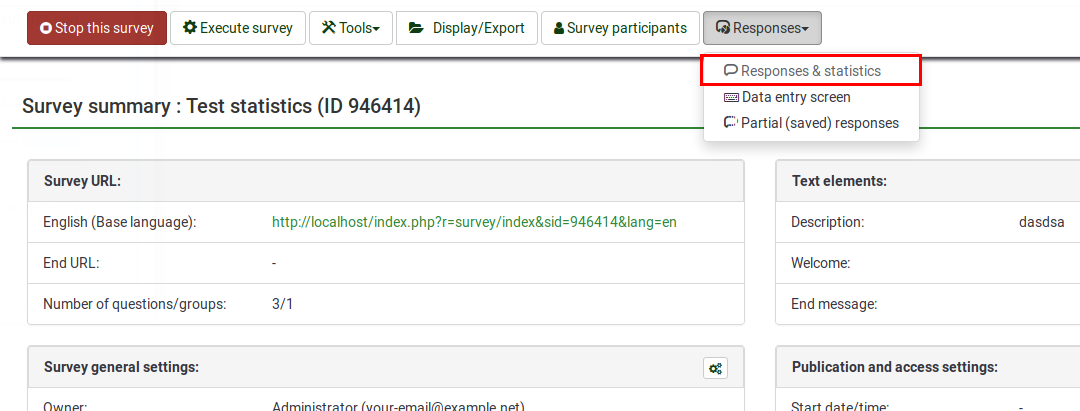
Standardmäßig wird die Antworten-Zusammenfassung angezeigt. Suchen Sie nun in der oberen Symbolleiste nach der Option "Exportieren":
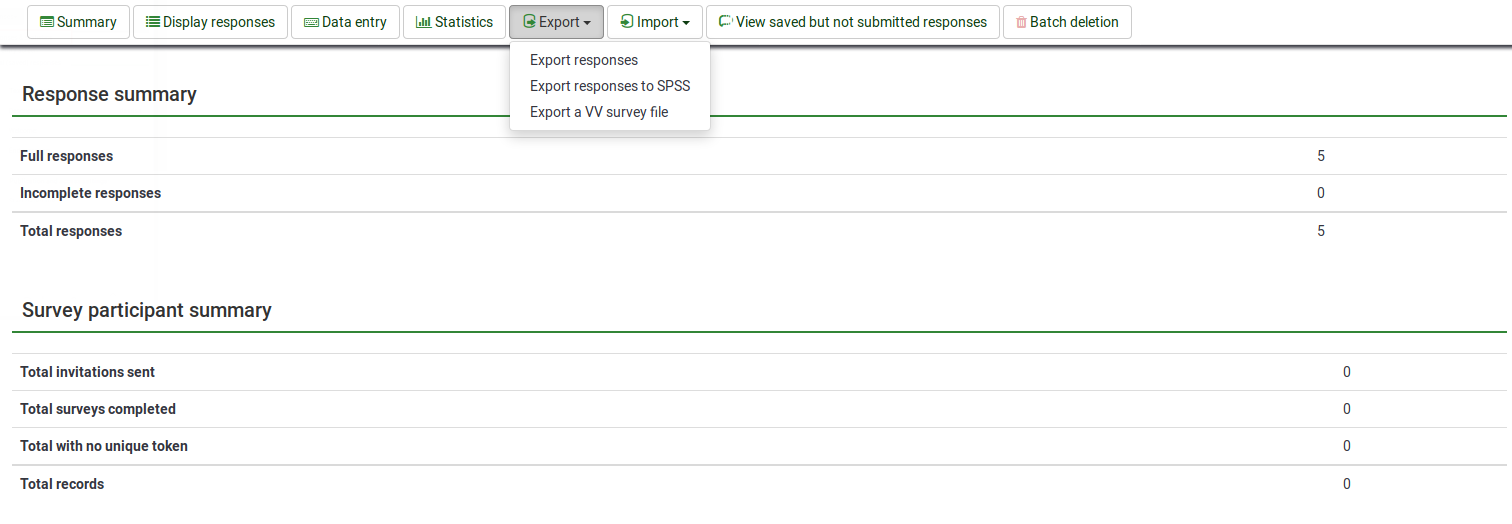
Es stehen mehrere Optionen zur Verfügung:
Antworten exportieren
Das folgende Fenster wird angezeigt, wenn die erste exportbezogene Option aus dem Dropdown-Menü ausgewählt wird:
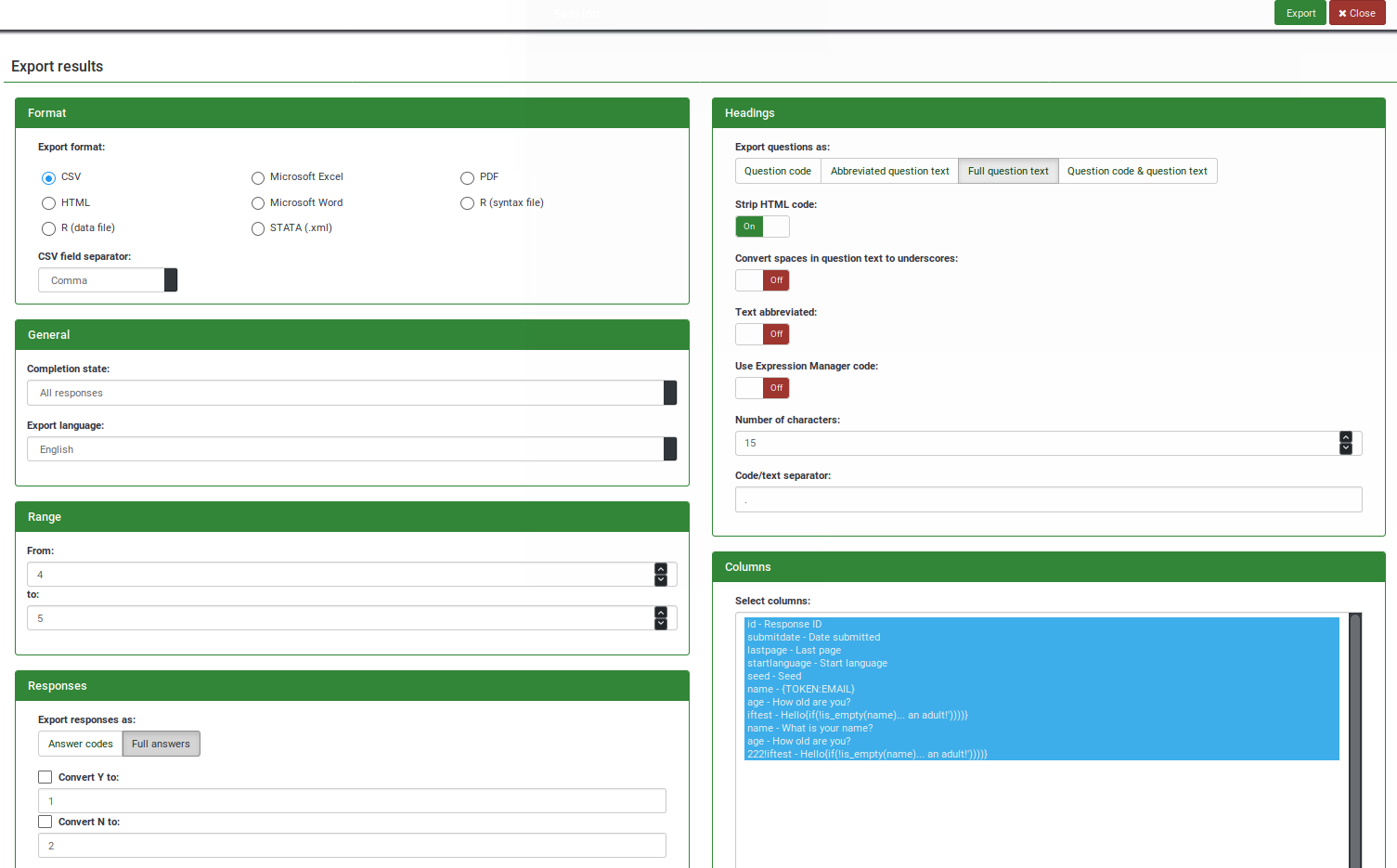
Mehrere Filteroptionen sind unterteilt in:
- Format: ermöglicht Ihnen die Auswahl des Formats, in dem Sie Ihre Ergebnisse exportieren möchten. Die folgenden Formate sind verfügbar:
- CSV-Datei (alle Zeichensätze): siehe auch die Option "CSV-Feldtrenner" unten auf der Registerkarte Format. Der Standardwert ist "Komma". Die anderen Optionen sind "Semikolon" und "Tabulator"
- HTML
- R (Datendatei): Wenn diese Option ausgewählt ist, exportieren Sie Ihre Umfrage bitte auch die R ( Syntaxdatei). Um mehr Details darüber zu erfahren, wie Sie Ihre Daten in R analysieren können, lesen Sie diesen Unterabschnitt
- Microsoft Word (lateinischer Zeichensatz)
- Microsoft Excel (alle Zeichensätze)
- STATA (.xml): für weitere Details zur Analyse Ihrer Daten in STATA lesen Sie den folgenden Unterabschnitt!
- R (Syntaxdatei): Wenn diese Option gewählt wird, exportieren Sie Ihre Umfrage bitte auch in R (Syntaxdatei). Um mehr Details darüber zu erfahren, wie Sie Ihre Daten in R analysieren können, lesen Sie diesen Unterabschnitt
- Allgemein
- Abschlussstatus: eingestellt, um alle Datensätze ODER nur abgeschlossene Datensätze ODER nur unvollständige Datensätze zu exportieren. Weitere Informationen zu ihrer Bedeutung finden Sie in diesem Wiki-Unterabschnitt
- Exportsprache: Die Standardoption ist die Basissprache Ihrer Umfrage
- Range: bezieht sich auf die ID der gespeicherten Antworten aus der Antworttabelle. Falls die eingegebenen Werte falsch sind (d. h. zwischen den eingegebenen Werten wurde keine Antwort-ID gefunden), wird ein Popup-Fenster angezeigt, wenn Sie versuchen, die Antworten zu exportieren, in dem Sie aufgefordert werden, Werte einzugeben, die in der Tabelle gefunden werden können.
- Antworten
- Antworten exportieren als: Sie können entweder vollständige Antworten exportieren oder Antwortcodes konvertieren. Wenn Letzteres ausgewählt ist, werden die von Ihren Befragten übermittelten Antworten durch den Antwortcode der jeweiligen Antwort ersetzt. „Ja“- und „Nein“-Antworten werden in „J“- und „N“-Antworten auf eine beliebige Zeichenfolge umgewandelt. Wenn „J/N umwandeln in“ aktiviert ist, werden die Antwortcodes, die J und N als Antworten verwenden, in die Zeichenfolgen aus den entsprechenden Feldern umgewandelt. Standardmäßig sind die Werte 1 für Y und 2 für N.
- 'Überschriften
- Frage exportieren als: legt fest, wie die Überschrift in der exportierten Datei aussehen soll. Folgende Optionen stehen zur Verfügung:
- Fragecode
- Abgekürzter Fragetext: Die Länge der Frage wird verkürzt, wenn diese Option ausgewählt ist (nützlich, wenn Sie mit langen Fragen arbeiten)
- *Vollständiger Fragetext (Standard)
- Fragecode und Fragetext
- „HTML-Code entfernen:“ ist standardmäßig aktiviert, um den in Fragetextfeldern verwendeten HTML-Code nicht zu exportieren
- Frage exportieren als: legt fest, wie die Überschrift in der exportierten Datei aussehen soll. Folgende Optionen stehen zur Verfügung:
- *Leerzeichen im Fragetext in Unterstriche umwandeln: standardmäßig deaktiviert. Wenn aktiviert, werden die Leerzeichen aus dem Fragetext in Unterstriche umgewandelt.
- Text abgekürzt: standardmäßig deaktiviert. Wenn aktiviert, wird der Fragetext gekürzt. Die Länge des Fragetextes ergibt sich aus der Zahl, die im Feld „Anzahl der Zeichen“ eingetragen ist. Bitte beachten Sie, dass diese Option in dem Fall nützlich ist, in dem Sie die Fragetexte abkürzen möchten, die sich aus der Auswahl von „Vollständiger Fragetext“ oder „Fragecode & Fragetext“ als Überschriftentext ergeben.
- ExpressionScript-Code verwenden : standardmäßig deaktiviert. Wenn diese Option aktiviert ist, werden die Fragen und Unterfragen exportiert, während sie im ExpressionScript verwendet werden. Daher würde die Überschrift der qcode-Variablenbenennung ähneln. Bitte beachten Sie, dass eine der folgenden Optionen für die Frageüberschrift ausgewählt werden muss: „Fragecode“ oder „Fragecode & Fragetext“.
- „Anzahl der Zeichen:“ legt eine maximale Anzahl von Zeichen fest, die in den Überschriften angezeigt werden sollen. Diese Option funktioniert, wenn Sie Ihre Frage als gekürzten Fragetext exportieren möchten. Die Standardzahl ist 15.
- „Code-/Texttrennzeichen:“ Wählen Sie die Option aus, die Sie verwenden möchten, um den Fragecode vom Text der Frage zu trennen. Standardmäßig ist es ein „Punkt“, gefolgt von einer leeren Zeichenfolge (<SPACE> ).
- Spaltensteuerung: legt die Fragen (und ihre entsprechenden Antworten) fest, die exportiert werden sollen. Die Fragen in dieser Liste werden durch ihren entsprechenden Fragecode und Fragetext dargestellt. Standardmäßig werden alle Spalten exportiert. Um mehrere Spalten auszuwählen, verwenden Sie die Tasten STRG und/oder UMSCHALT.
- Token-Steuerung - legt fest, welche 'Umfrageteilnehmerdaten exportiert werden sollen. Diese Option ist nur verfügbar, wenn Ihre Umfrage nicht anonym ist! Klicken Sie hier für weitere Informationen darüber, was eine Umfrageteilnehmertabelle ist und wie Sie sie in LimeSurvey verwenden können.
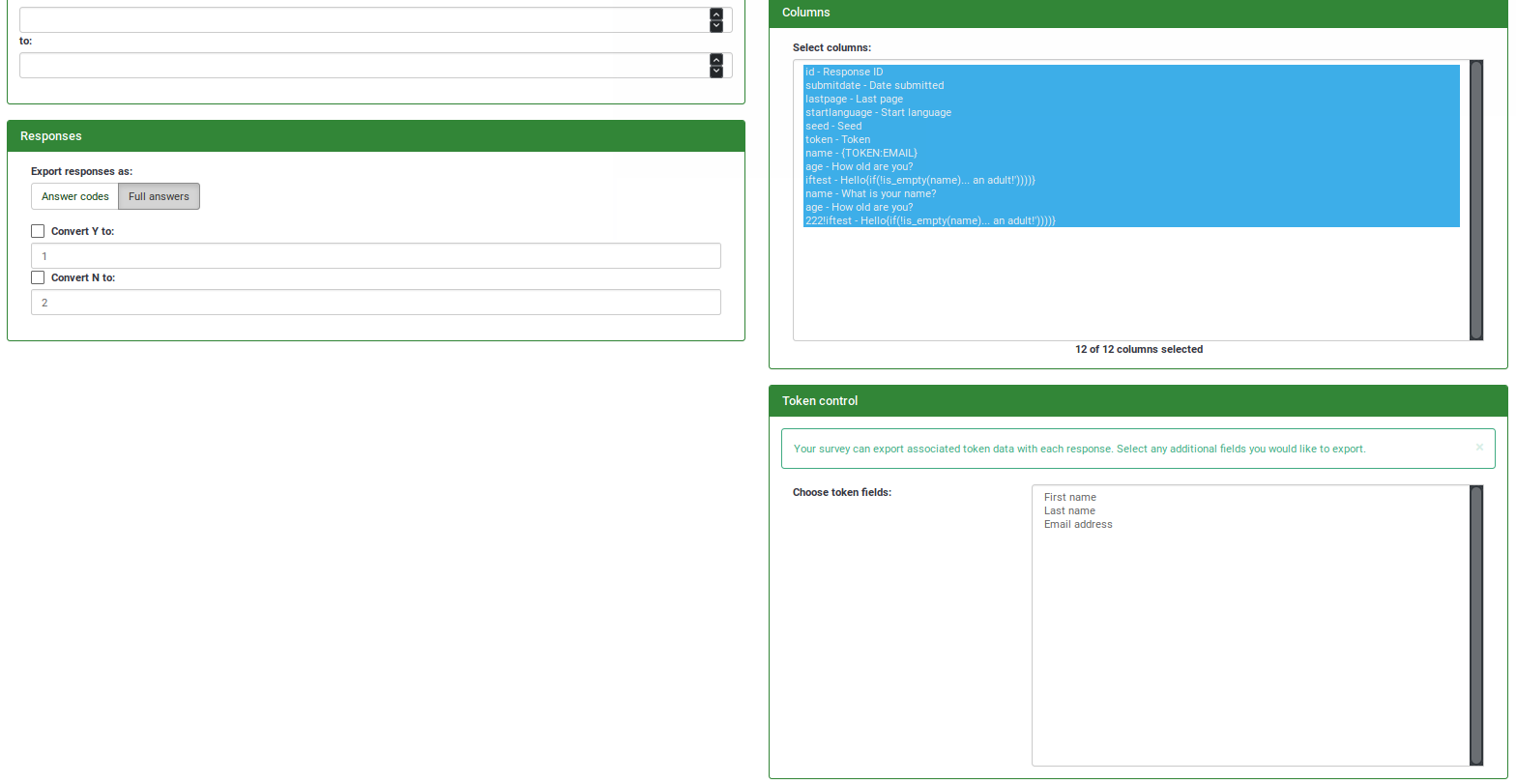
Export nach R
Die kostenfreie Softwareumgebung R ist eine Alternative zu SPSS für statistische Berechnungen und Grafiken.
'Folgen Sie diesen Schritten, um Ihren Datensatz in R zu importieren:
- Laden Sie „sowohl“ die Syntaxdatei als auch die Datendatei herunter
- Speichern Sie beide Dateien in Ihrem R-Arbeitsverzeichnis (verwenden Sie „getwd()“ und „setwd()“ in einem R-Befehlsfenster, um Holen Sie sich Ihr Arbeitsverzeichnis und legen Sie es fest)
- Geben Sie
source("File_name_syntax.R")im R-Befehlsfenster ein. Die Daten werden im richtigen Format in einen Datenrahmen namens „Daten“ importiert.
Antworten mit eingeschränkten Optionen werden faktorisiert, wobei die Ebenen dem Code der Frage und die Beschriftungen den Optionen entsprechen.
Bei Fragen mit der Option „Sonstiges“ wird das Fragefeld mit „_Sonstiges“ als neue Spalte für die anderen Daten angehängt.

Stata-XML exportieren
Stata ist ein kommerzielles Datenanalyse- und Statistik-Softwarepaket.
Diese Exportroutine wurde erstellt, um eine schnelle Analyse der mit LimeSurvey gesammelten Daten zu ermöglichen. Es erstellt eine XML-Datei im proprietären Format von Stata. Dieses Format bietet mehrere Vorteile gegenüber dem Import einfacher CSV-Dateien:
- Datensätze sind vollständig beschriftet, einschließlich Variablenbeschriftungen (Frage, Unterfrage) und Wertebeschriftungen (Antworten, falls zutreffend).
- Daten werden bereits in das interne Datum von Stata umgewandelt Format und können somit direkt zur Berechnung von Differenzen zwischen Tagen usw. verwendet werden.
- Variablennamen werden bei Bedarf in ein Stata-kompatibles Format konvertiert.
- Datenformate von Variablen (String, Integer, Float usw.) sind bereits entsprechend den zugrunde liegenden Daten festgelegt (keine Zahlen mehr, die als Zeichenfolgen kodiert sind!).
So laden Sie die Datei in Stata:
- Klicken Sie im Menü von Stata auf Datei, Importieren, xml-data
- Wählen Sie „Durchsuchen“, um zu Ihrer exportierten Datei zu navigieren, und klicken Sie auf „OK“.
- Aufgrund einer Einschränkung im Datenformat von Stata darf die Länge von Zeichenfolgenvariablen (Textvariablen) maximal 244 Zeichen (Stata-Versionen 8–12) und 2045 Zeichen (Stata-Version) betragen 13 und höher). Bitte geben Sie in den Einstellungen des Export-Plugin Ihre Stata-Version an:


- Stata unterstützt nur das Anhängen von Wertbeschriftungen an numerische Werte. Um kurze Antworten (normalerweise ein oder zwei Ziffern) zu erhalten und diese richtig zu kennzeichnen, sollte man in LimeSurvey numerische Antwortcodes verwenden (1=stimme voll und ganz zu). Wenn nicht-numerische Antwortcodes verwendet werden (A=Stimme voll und ganz zu), dann wird der vollständige Antworttext als Antwort verwendet (z. B. „Stimme voll und ganz zu“).
Antworten nach SPSS exportieren
SPSS Statistics ist ein Softwarepaket, das zu statistischen Analysen verwendet wird. Sie können das offizielle SPSS-Paket nutzen, oder PSPP als Ersatz für das proprietäre Programm SPSS verwenden.
To export your response data to SPSS, go to Responses & statistics section and select the SPSS-corresponding option located under the Export menu:

The following page is displayed:

The following options are displayed in the panel:
- Data selection: you can select which data should be selected for export: all responses OR only complete responses OR only incomplete responses
- SPSS version: Check your SPSS installation version. Three different export options can be chosen: "Prior to version 16 / PSPP", "16 or up" and "16 or up with Python Essentials"
- Language: acts like a filter that allows you to filter the exported responses based on the language used to fill out the survey
- Limit: type in any numerical value to get exported only the first "n" entries from your response table
- Offset: type in any numerical value to get exported your response table without the first "n" entries from your response table
- No answer: if left empty, an empty string is stored as answer for the questions that have not been answered by respondents. Type in this box any string of characters to replace the empty string. The set of characters will be displayed in the exported .dat file
SPSS export includes two files:
- a syntax file (survey_xxxx_SPSS_syntax_file.sps)
- and a data file (survey_xxxx_SPSS_data_file.dat).
After having downloaded these files you can open them using a raw text editor like notepad to take a look how the exported data looks like. The syntax file holds the commands that should be run to import the data. It is like a programming language inside SPSS. The .dat file contains a comma separated file with all data. We recommend you not to import your data as csv because there is the risk of loosing information about questions, label sets, and so on.
Import LimeSurvey responses to SPSS
To import your data to SPSS, pursue these steps:
- Download the data and the syntax file.
- Open the syntax file in SPSS in Unicode mode.
- Edit the 'FILE=' line and complete the filename with a full path to the downloaded data file.
- Choose 'Run/All' from the menu to run the import.
- Done
VVExport
Once you've begun collecting responses, there may be occasions where you need to be able to directly edit and modify large quantities of data from your responses table (where a spreadsheet tool may be more useful).
VVExport (the "VV" stands for vertical verification) allows you to export your responses table into a .csv file. So long as the general structure of the file remains intact, you can then edit values within it, and then import the file again into your responses table using the "VVImport" feature.
It is often used in three scenarios:
- In the first one, it is used to combine large amounts of data in one LimeSurvey installation. Imagine that you run two similar surveys on two different machines. In order to combine the two response tables, you will have to use VVExport, VVImport, and a third-party app (e.g., spreadsheet apps) to combine your data and put it on one LimeSurvey installation.
- It may also be used to edit the response table of a survey. For small edits, you can access the response table and edit the desired answers. Still, for "macro-editing", VVExport and VVImport are recommended because a spreadsheet program can help you quickly edit dozens of responses at the same time.
- A "vv survey file" allows you to import the responses to a survey when the question/answer combinations have changed. Effectively, this allows you to add or remove questions in an active survey.
To export your data via VVExport, go to Responses & statistics section and select the VV-corresponding option located under the Export menu:

The following page will be loaded:

- Survey ID:: The ID of the survey to be exported
- Export: The completion state of the responses to be exported:
- Completed responses only: if a respondent reaches the last page of a survey and clicks the Submit button, then his or her response is marked as being complete
- Incomplete responses only: if a respondent does not click on that Submit button located before the end page, then the response is marked as being incomplete
- All responses: export both completed and incomplete responses
- File extension: The file extension. The file is a TSV (tab-separated values) file. For easy opening in MS-Excel set the extension to .txt. If you use LibreOffice, OpenOffice or any other spreadsheet program, you can leave it to .csv (default format)
- VV export version: The 1.0 version (Old VV version) uses database column headers, version 2.0 (Last VV version) uses Qcode Variable Naming. Version 2.0 is selected by default if all of your question code are unique.
- If you want to import responses using "VVImport" make sure to check whether the responses should be added to the existing responses or all responses should be overwritten.
- If you are trying to import responses from a different yet identical (e.g., identical questions/answers from another survey), make sure you are using the correct vv file and that the first two lines of the .csv file are correct.
- If you import a survey to your LimeSurvey installation the SID will not change (if possible). The group id and question id however might change. So you might have to adjust the first two heading lines to match the new group id/question id.
Exporting a VV survey file
When you choose to export responses using VVExport, you will be given the option to choose whether you want to export all responses or complete responses only or incomplete responses only. The file extension allows you to choose which extension the exported file will have. For easy use, .csv should be chosen.
The first two rows of the spreadsheet/tab-delimited file are the column labels. The first row is a "human readable" column heading that details the name of the question/answer field. The second row is the internal PHP/database column name for that response.
You should not modify the first two rows of this spreadsheet if you want to be able to "import" the data back into LimeSurvey at a later point.
VV files structure - example
VV version 1 TSV file
Response ID Date submitted Last page Start language Token please vote from 1 to 6 (1 - super, 6 - worst)
id submitdate lastpage startlanguage token 46492X40X1991
183 09.11.11 11:44 3 de jsfhusdgqfygqsy 4
184 09.11.11 11:53 3 de sdfhsifgsyergze 2
190 09.11.11 11:44 3 de qsdqshkfhkdsjhj 1
VV version 2 TSV file
Response ID Date submitted Last page Start language Token please vote from 1 to 6 (1 - super, 6 - worst)
id submitdate lastpage startlanguage token QCODE
183 09.11.11 11:44 3 de jsfhusdgqfygqsy 4
184 09.11.11 11:53 3 de sdfhsifgsyergze 2
190 09.11.11 11:44 3 de qsdqshkfhkdsjhj 1
In this example, the SQGA identifiers are not used - instead, the Qcode variable naming QCODE is used in the second line.
We generally recommend our users to use question codes since they are much easier to be used (it represents an addition to the SGQA system used in the earlier versions of LimeSurvey.
Reserved names
A .vv file uses left and right brackets for reserved names. When importing, this string is replaced by:
{question_not_shown}: NULL value in database. LimeSurvey uses [empty string] for not answered question, and NULL value for questions not shown.{quote}: " (a double quote){cr}: Carriage return{newline}: A new line{lbrace}: Left bracket (for example, if you want to have {cr} in response : use{lbrace}{cr})
Editing a VV survey file
When a .vv file has been successfully exported you can use a spreadsheet tool to open and edit the file. If you have to choose a column separator when opening the file please use the "Tab" character. If you are using non-ASCII characters make sure you set "UTF-8" as character set.
If you simply wish to simply edit your data, then be careful at the first two columns so that you can later easily VVImport your data back into your LimeSurvey installation!
If you combine data from two different surveys, please note that the old VV version uses SGQA which will most probably give you different "question ids". Therefore, be careful how you merge the data!
The alternative would be to use the last VV version because question codes can be constant throughout different LimeSurvey installations (if you use the same survey structure across multiple LimeSurvey instances).
When importing the VV file, if two response IDs match and the Exclude record IDs is disabled, you can make LimeSurvey:
- Report and skip the new record
- Renumber the new record
- Replace the existing record
- Replace answers in file in the existing record
Other export options
In case you do not need to export the whole survey, you can also choose to export only:
Export a single response
If you want to export an individual response, you can do it in two ways:
1. Login to LimeSurvey, choose your survey, click on Notifications & data tab and make sure you receive basic email notifications:
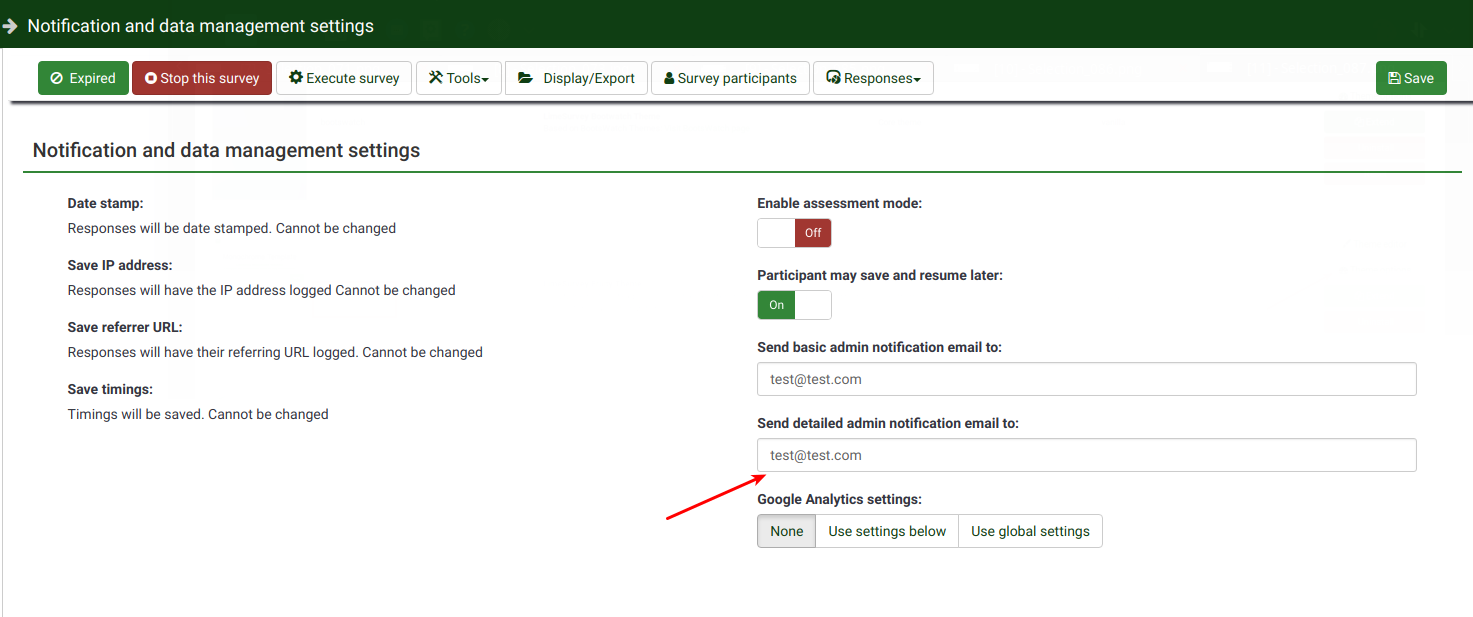
Every time someone has completed a survey, you will receive an email with a link: "Click the following link to see the individual response". This will take you to a page with a button above the response data saying "Export this response":

Choose how the single response will be exported:

2. Login to your LimeSurvey installation/instance, choose your survey. Select tab Responses located under the settings tab:

See the "action" column. Hover the mouse over each option and see which one allows you to see the response details (the first button):
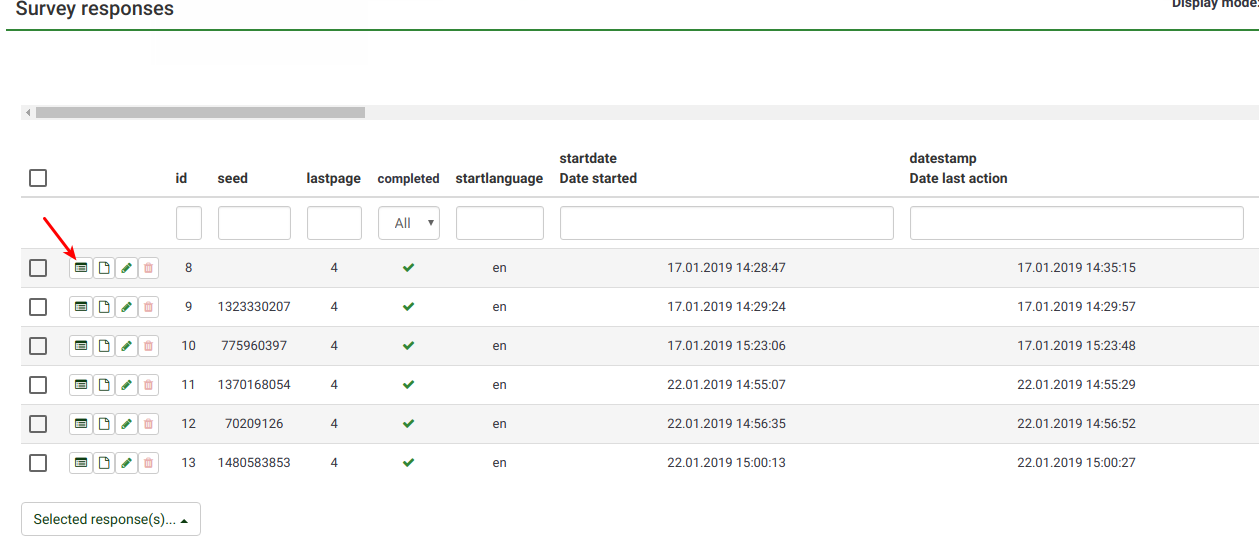
The response entry will be loaded. Click on the "Export this response" button. You will be redirected to a panel from where you can select how the exported file should look like:

As you can observe, you can also export the response as a pdf file:

This option is usually needed when you wish to share to one of your respondents his/her results. In the case in which you wish to share only certain parts of his/her answer, check the pdf export option located in the Statistics panel. In this way, you can hide your hidden questions and/or different assessments you run "in the background".
Export a group of responses
This option is useful in the case in which you wish to export a certain group of filtered responses.
To do it, access your Responses table table:

You can either order the responses according to the value from each column by clicking on the column label or you can type in the empty boxes located below the column labels a string of characters according to which you wish your data to be filtered to.

Once done, your table should look like the one below. Now, tick all the filtered responses, click on the Selected response(s)... button located in the bottom left side of the response table, and select the Export button:
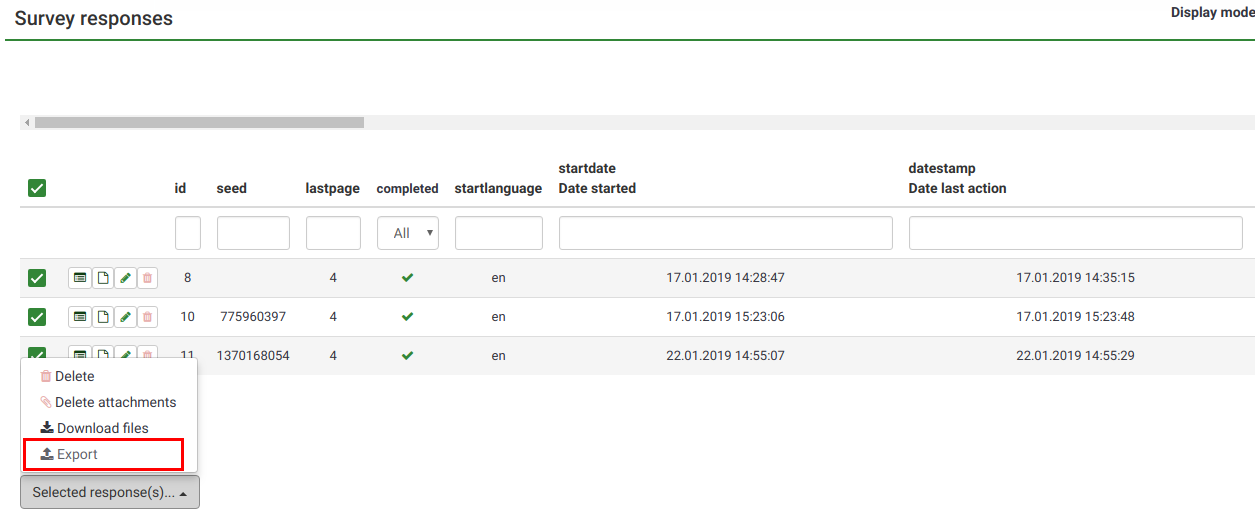
The next page will be loaded:
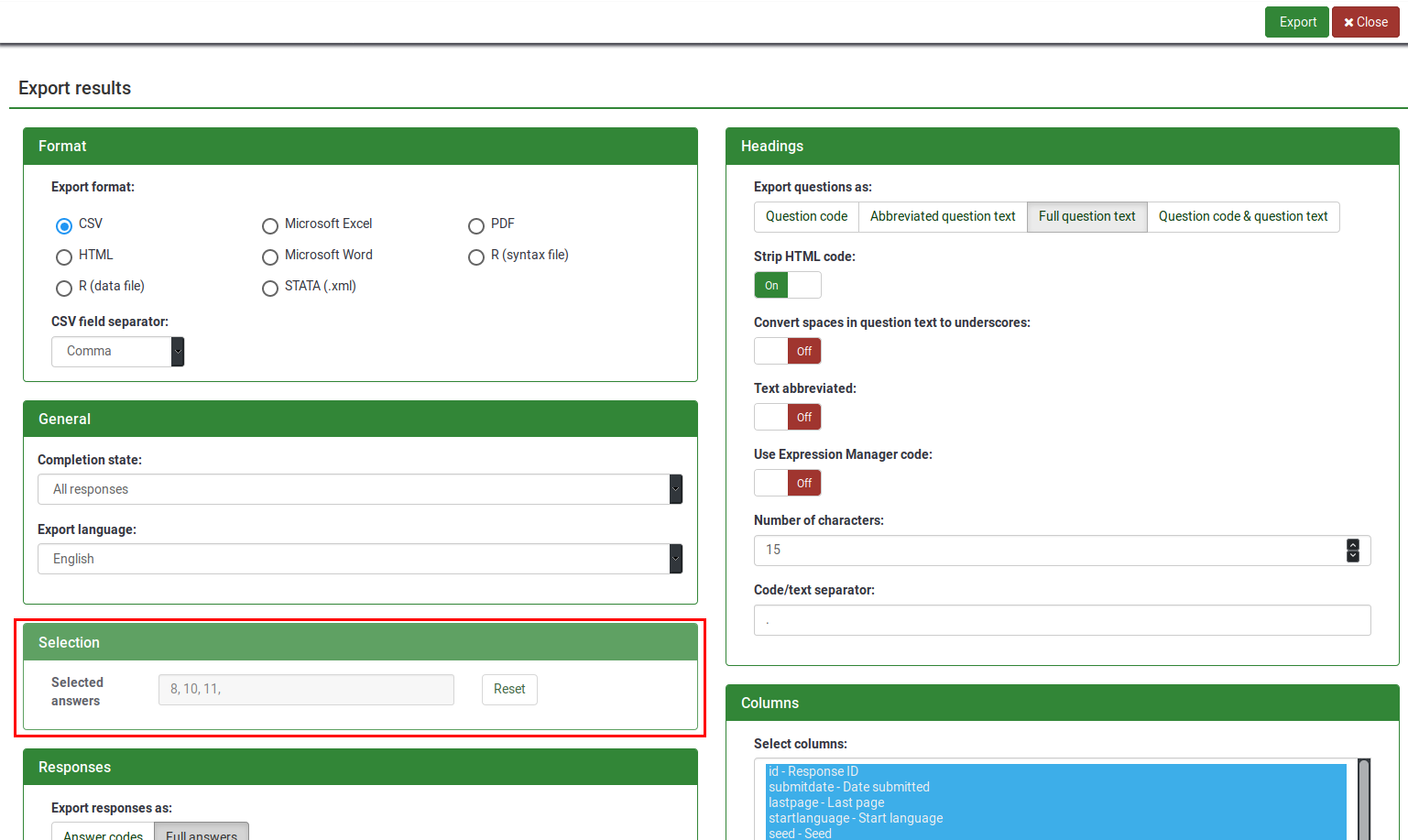
The Range column is not displayed since you have already selected the entries you wish to export. To check those IDs, check Selection (see the above screenshot). You can click on Reset if you wish to export all your data instead.